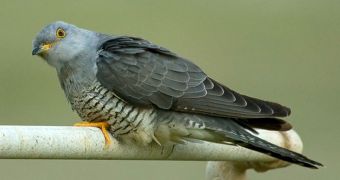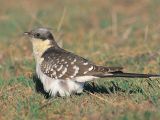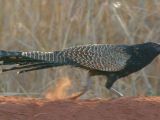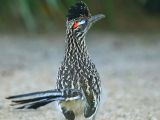1. Cuckoos are classified as belonging to their own order of birds, not closely related to other living birds. Only the weird hoatzin bird of the Amazon is distantly related to cuckoos. Cuckoos are most famous for their habit of brood parasitism. Only 2 out of 5 families of cuckoos comprise species that are brood parasites: Cuculidae (of which only 3 genera are not nest parasites) and 3 genera of the American family Neomorphidae (comprising the famous roadrunner, which does not parasitize the nests of other birds).
The largest cuckoo is the pheasant coucal (Centropus phasianinus) of New Guinea and neighboring islands: it is 80 cm (2.6 ft) long, and almost as big as a pheasant.
The smallest cuckoo is the yellow-throated cuckoo (Chrysococcyx flavigularis) of the African rainforest: 20 cm (8 in) long.
2. Of course, the phenomenon of brood parasitism is best investigated in the case of the common cuckoo (Cuculus canorus) from Eurasia and Africa. The species can parasitize about 100 species of song birds, but the preferred ones are about 12, like meadow pipit (Anthus pratensis), reed warbler (Acrocephalus scirpaceus), sedge warbler (A. schoenobenus), hedge accentor (Prunella modularis), European robin (Erithacus rubecula), winter wren (T. troglodytes), white wagtail (Motacilla alba) and yellow wagtail (M. flava).
Sometimes, the egg is deposited in a wrong nest (like that of seed eating birds, moorhens, or plovers) because of the lack of available nests or the lack of experience in the case of the female cuckoo. These cuckoo chicks perish. A cuckoo female lays eggs of a single type, thus it will prefer a single host species, with which it synchronizes its breeding period. Its chicks will prefer the same host. Cuckoos scare birds away from their nest in order to lay their egg, and they accomplish this because of their plumage pattern resembling that of a sparrowhawk.
A cuckoo female produces 10 to 20 eggs during a breeding season, of which only 50 % hatch. Many cuckoo eggs fail to trick the host and are tossed out of the nest, or the nests themselves are abandoned.
The freshly hatched cuckoo chick will toss the other eggs out of the nest and the chicks of the host. Its back is concave, and the reflex of emptying the nest is determined by the sensitive skin on the dorsal part. If the cuckoo chick is caught while tossing the eggs and the chicks of the host, it will adopt an indifferent or cooperative attitude. If a nest hosts 2 cuckoo chicks, one will eventually eliminate the other.
The sounds emitted by the cuckoo chicks, together with the red-orange roof of the mouth prompt the host to feed them, neglecting their own chicks. The cuckoo chick can eat as much as 4-5 chicks of the host.
As an adaptation to brood parasitism, the cuckoo eggs are extremely small compared to the size of the female, weighing 2-3 g while the females have around 100 g (0.2 pounds).
The territory of the male cuckoo depends on the availability of food and nests (it varies from 12 to 155 ha) and it can comprise those of several females (a female has a territory of 2,5-50 ha).
3. Cuckoos eat caterpillars, beetles, dragonflies, mayflies, larvae, slugs, snails and froglets. They accumulate fat before the 4-5,000 km (2,500-3,000 mi) long migration, when their body weight reaches 161 g. Cuckoos migrate in groups, during the night. They fly well and cross the Mediterranean from Europe to Africa (and vice versa) directly, at a height of 300 m (1,000 ft).
4. The great spotted cuckoo (Clamator glandarius) and related species, larger than the common cuckoo (40 cm (1.3 ft) long compared to 33 cm (1.1 ft) in the case of the later) parasitizes the nests of birds from the crow's family (mainly jays and magpies) and oxpeckers (Buphagus) in Africa. The parents keep a lookout to see if the hosts take care of their eggs and destroy the nest, swallowing the eggs and the chicks if the hosts eliminate their egg. They even become violent if the host does not take care of their chicks.
The small emerald cuckoos (Chrysococcyx) parasitize mainly weaver birds.
5. The ani cuckoos (Crotophaga) of tropical America not only do not parasitize, but they even build a common nest where several females incubate the eggs lain by all the females of the group (about 20 eggs). Young non-reproductive birds help with raising the chicks of the group.
6. The roadrunner (Geococcyx californianus) is a terrestrial cuckoo of the deserts of the southwestern US and Mexico that reached international "fame" thanks to a series of popular cartoons. Still, the question remains: just how rapid is this bird? It can reach 40 km (25 mi) per hour, much faster than a human (this is even more amazing because of the small size of the bird), but it's clearly no match on the road for a real life coyote, which in warm-up mode reaches 56 km (35 mi) per hour.

 14 DAY TRIAL //
14 DAY TRIAL // 


